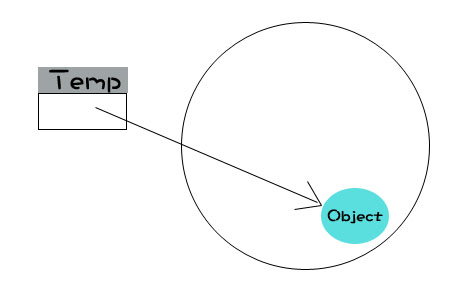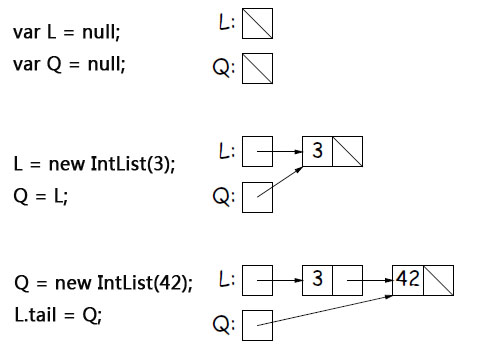Javascript引用指针使用介绍_javascript技巧
请尝试完成下列完形填空:
/* 创建一个队列,头为head0,尾为tail0 */
function IntList(head0, tail0){
this.head = head0 || 0;
this.tail = tail0 || null;
}
/* 返回一个IntList包含数组中的所有数 */
IntList.list = function(__args){
var sentinel = new IntList(),
len = __args.length,
p = sentinel;
for(var i = 0; i p.tail = new IntList(__args[i]);
p = p.tail;
}
return sentinel.tail;
};
/* 返回该对象的字符串表示 */
IntList.prototype.toString = function(){
var temp = "";
temp += "[";
for(var L = this; L !== null; L = L.tail){
temp = temp + " " + L.head;
}
temp += " ]";
return temp;
};
/** 返回一个IntList,包含IntList A和IntList B,
* 其中B的元素在A的后面。不能使用new关键字。
*/
function dcatenate(A, B){
/* 完成功能 */
}
/** 返回一个新的IntList,其长度为len,
* 以#start元素为开头(其中#0是第一个元素),
* 不能改变L。
*/
function sublist(L, start, len){
/* 完成功能 */
}
这是一个用Javascript写的链表题。由于链表拥有较为复杂的引用操作,正好可以用来考察下对Javascript的引用的理解。附带简单的测试用例:
/* 测试dcatenate和sublist函数是否正确 */
function test(){
var A = IntList.list([4,6,7,3,8]),
B = IntList.list([3,2,5,9]);
dcatenate(A, B);
if(A.toString() === "[ 4 6 7 3 8 3 2 5 9 ]"){
alert("dcatenate函数正确。");
}else{
alert("dcatenate函数错误。");
}
var L = IntList.list([3,4,5,2,6,8,1,9]),
result = sublist(L, 3, 3);
if(result.toString() === "[ 2 6 8 ]"){
alert("sublist函数正确。");
}else{
alert("sublist函数正确。");
}
}
Javascript引用?
实际上,在对变量赋予引用类型实例时,变量保存的是该实例的引用:
var temp = new Object();

这种表现非常切合它的名字,引用类型,其实例当然是来引用的。
而当将该变量再付给另一个变量的时候,实际上只是进行了对引用的复制操作:
var temp2 = temp;

所以虽然从定义式来看:temp2 = temp,但他们并没有直接联系,例如修改了temp的引用:
var temp = {
name: "temp"
};
var temp2 = temp;
temp = {
name: "not temp2"
};
temp === temp2; //false
当然,如果我们修改的只是指针指向的实例本身,那么temp2依然等于temp:
var temp = {
name: "temp"
};
var temp2 = temp;
temp.name = "also temp2";
temp === temp2; //true
IntList是什么东东?
我们来分析一下下图:

- 创建两个空的变量,所以右图中L和Q是空的。创建一个新的IntList其头部为3,尾部为空,将L引用的值赋给Q,所以L和Q都指向这个新的IntList。Q指向一个新创建的IntList其头部为42,尾部为空,将Q的指针赋给L.tail,这样两个IntList被套嵌起来。
可见IntList是个通过指针达到多重套嵌的数据结构,被称为链表(Linked List)。
1.创建两个空的变量,所以右图中L和Q是空的。2.创建一个新的IntList其头部为3,尾部为空,将L引用的值赋给Q,所以L和Q都指向这个新的IntList。
3.Q指向一个新创建的IntList其头部为42,尾部为空,将Q的指针赋给L.tail,这样两个IntList被套嵌起来。
可见IntList是个通过指针达到多重套嵌的数据结构,被称为链表(Linked List)。
IntList合并
我们只需要将其中一个的尾部指向另一个就行了。这样这两个IntList就连接起来了:
/** 返回一个IntList,包含IntList A和IntList B,
* 其中B的元素在A的后面。不能使用new关键字。
*/
function dcatenate(A, B){
var p;
for(p = A; p != null; p = p.tail){
if(p.tail === null){
p.tail = B;
break;
}
}
return A
}
IntList截取
由于题目要求不能改变原IntList,所以我们只能从原IntList取出数据再重建一个新的数据。
/** 返回一个新的IntList,其长度为len,
* 以#start元素为开头(其中#0是第一个元素),
* 不能改变L。
*/
function sublist(L, start, len){
var K,
P,
J;
var i = 0,
end = start + len;
for(P = L; i if(i continue;
}else if(i === start){
K = new IntList(P.head);
J = K;
}else if(i > start && i J.tail = new IntList(P.head);
J = J.tail;
}else if(i >= end){
break;
}
}
return K;
}
思考题
1.函数传参数的时候是怎么传的?例如下面代码的引用过程是怎样的?
var obj = {
name: "anything"
};
function getName(__obj){
return __obj.name;
}
var name = getName(obj);

Heiße KI -Werkzeuge

Undresser.AI Undress
KI-gestützte App zum Erstellen realistischer Aktfotos

AI Clothes Remover
Online-KI-Tool zum Entfernen von Kleidung aus Fotos.

Undress AI Tool
Ausziehbilder kostenlos

Clothoff.io
KI-Kleiderentferner

AI Hentai Generator
Erstellen Sie kostenlos Ai Hentai.

Heißer Artikel

Heiße Werkzeuge

Notepad++7.3.1
Einfach zu bedienender und kostenloser Code-Editor

SublimeText3 chinesische Version
Chinesische Version, sehr einfach zu bedienen

Senden Sie Studio 13.0.1
Leistungsstarke integrierte PHP-Entwicklungsumgebung

Dreamweaver CS6
Visuelle Webentwicklungstools

SublimeText3 Mac-Version
Codebearbeitungssoftware auf Gottesniveau (SublimeText3)

Heiße Themen
 1378
1378
 52
52
 Wie erstelle ich meine eigenen JavaScript -Bibliotheken?
Mar 18, 2025 pm 03:12 PM
Wie erstelle ich meine eigenen JavaScript -Bibliotheken?
Mar 18, 2025 pm 03:12 PM
In Artikel werden JavaScript -Bibliotheken erstellt, veröffentlicht und aufrechterhalten und konzentriert sich auf Planung, Entwicklung, Testen, Dokumentation und Werbestrategien.
 Wie optimiere ich den JavaScript -Code für die Leistung im Browser?
Mar 18, 2025 pm 03:14 PM
Wie optimiere ich den JavaScript -Code für die Leistung im Browser?
Mar 18, 2025 pm 03:14 PM
In dem Artikel werden Strategien zur Optimierung der JavaScript -Leistung in Browsern erörtert, wobei der Schwerpunkt auf die Reduzierung der Ausführungszeit und die Minimierung der Auswirkungen auf die Lastgeschwindigkeit der Seite wird.
 Was soll ich tun, wenn ich auf den Codendruck auf Kleidungsstücke für Front-End-Thermalpapier-Quittungen stoße?
Apr 04, 2025 pm 02:42 PM
Was soll ich tun, wenn ich auf den Codendruck auf Kleidungsstücke für Front-End-Thermalpapier-Quittungen stoße?
Apr 04, 2025 pm 02:42 PM
Häufig gestellte Fragen und Lösungen für das Ticket-Ticket-Ticket-Ticket in Front-End im Front-End-Entwicklungsdruck ist der Ticketdruck eine häufige Voraussetzung. Viele Entwickler implementieren jedoch ...
 Wie debugge ich den JavaScript -Code effektiv mithilfe von Browser -Entwickler -Tools?
Mar 18, 2025 pm 03:16 PM
Wie debugge ich den JavaScript -Code effektiv mithilfe von Browser -Entwickler -Tools?
Mar 18, 2025 pm 03:16 PM
In dem Artikel werden effektives JavaScript -Debuggen mithilfe von Browser -Entwickler -Tools, der Schwerpunkt auf dem Festlegen von Haltepunkten, der Konsole und der Analyse der Leistung erörtert.
 Wer bekommt mehr Python oder JavaScript bezahlt?
Apr 04, 2025 am 12:09 AM
Wer bekommt mehr Python oder JavaScript bezahlt?
Apr 04, 2025 am 12:09 AM
Es gibt kein absolutes Gehalt für Python- und JavaScript -Entwickler, je nach Fähigkeiten und Branchenbedürfnissen. 1. Python kann mehr in Datenwissenschaft und maschinellem Lernen bezahlt werden. 2. JavaScript hat eine große Nachfrage in der Entwicklung von Front-End- und Full-Stack-Entwicklung, und sein Gehalt ist auch beträchtlich. 3. Einflussfaktoren umfassen Erfahrung, geografische Standort, Unternehmensgröße und spezifische Fähigkeiten.
 Wie verwende ich Quellkarten zum Debuggen, um den JavaScript -Code zu debuggen?
Mar 18, 2025 pm 03:17 PM
Wie verwende ich Quellkarten zum Debuggen, um den JavaScript -Code zu debuggen?
Mar 18, 2025 pm 03:17 PM
In dem Artikel wird erläutert, wie Quellkarten zum Debuggen von JavaScript verwendet werden, indem er auf den ursprünglichen Code zurückgegeben wird. Es wird erläutert, dass Quellenkarten aktiviert, Breakpoints eingestellt und Tools wie Chrome Devtools und WebPack verwendet werden.
 Erste Schritte mit Chart.js: Kuchen-, Donut- und Bubble -Diagramme
Mar 15, 2025 am 09:19 AM
Erste Schritte mit Chart.js: Kuchen-, Donut- und Bubble -Diagramme
Mar 15, 2025 am 09:19 AM
In diesem Tutorial wird erläutert, wie man mit Diagramm.js Kuchen-, Ring- und Bubble -Diagramme erstellt. Zuvor haben wir vier Chart -Arten von Charts gelernt. Erstellen Sie Kuchen- und Ringdiagramme Kreisdiagramme und Ringdiagramme sind ideal, um die Proportionen eines Ganzen anzuzeigen, das in verschiedene Teile unterteilt ist. Zum Beispiel kann ein Kreisdiagramm verwendet werden, um den Prozentsatz der männlichen Löwen, weiblichen Löwen und jungen Löwen in einer Safari oder den Prozentsatz der Stimmen zu zeigen, die verschiedene Kandidaten bei der Wahl erhalten. Kreisdiagramme eignen sich nur zum Vergleich einzelner Parameter oder Datensätze. Es ist zu beachten, dass das Kreisdiagramm keine Entitäten ohne Wert zeichnen kann, da der Winkel des Lüfters im Kreisdiagramm von der numerischen Größe des Datenpunkts abhängt. Dies bedeutet jede Entität ohne Anteil
 Der Unterschied in der Konsole.log -Ausgabeergebnis: Warum unterscheiden sich die beiden Anrufe?
Apr 04, 2025 pm 05:12 PM
Der Unterschied in der Konsole.log -Ausgabeergebnis: Warum unterscheiden sich die beiden Anrufe?
Apr 04, 2025 pm 05:12 PM
Eingehende Diskussion der Ursachen des Unterschieds in der Konsole.log-Ausgabe. In diesem Artikel wird die Unterschiede in den Ausgabeergebnissen der Konsolenfunktion in einem Code analysiert und die Gründe dafür erläutert. � ...




